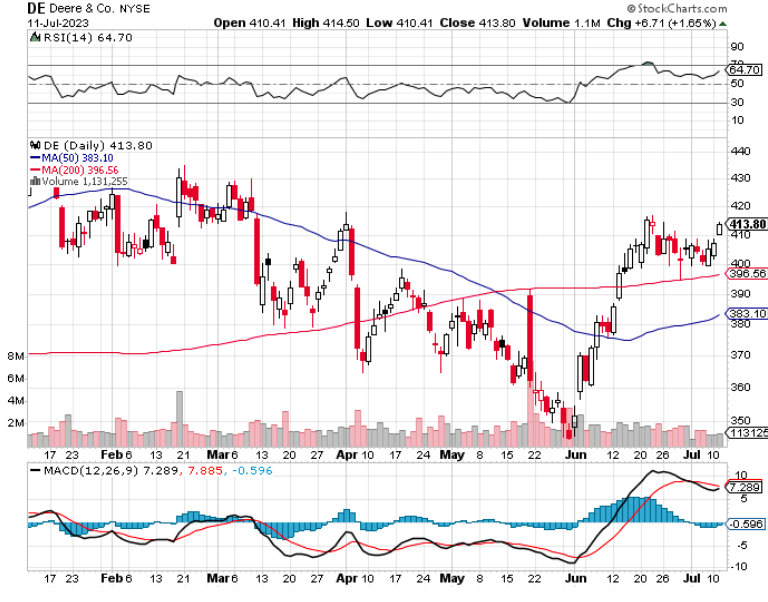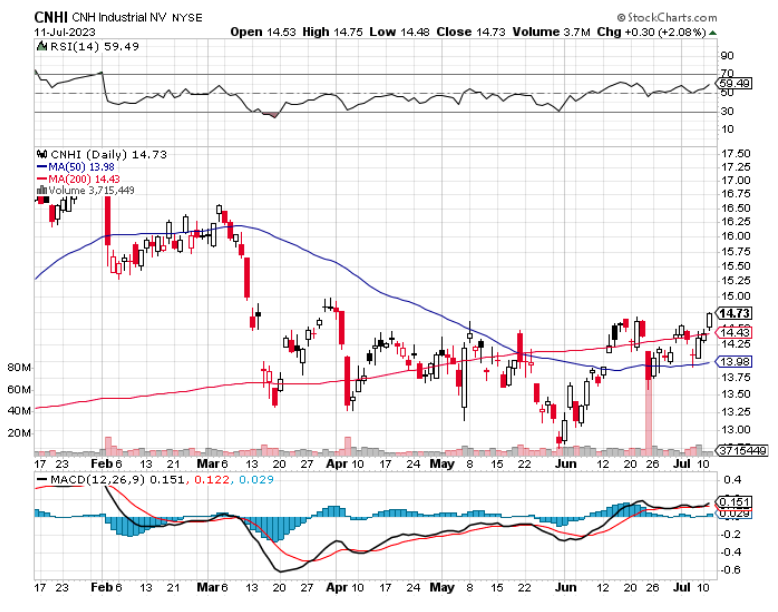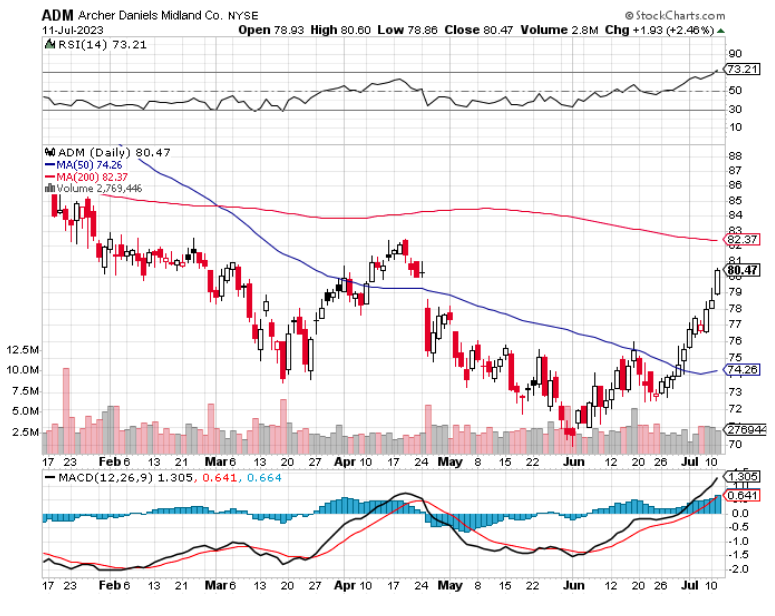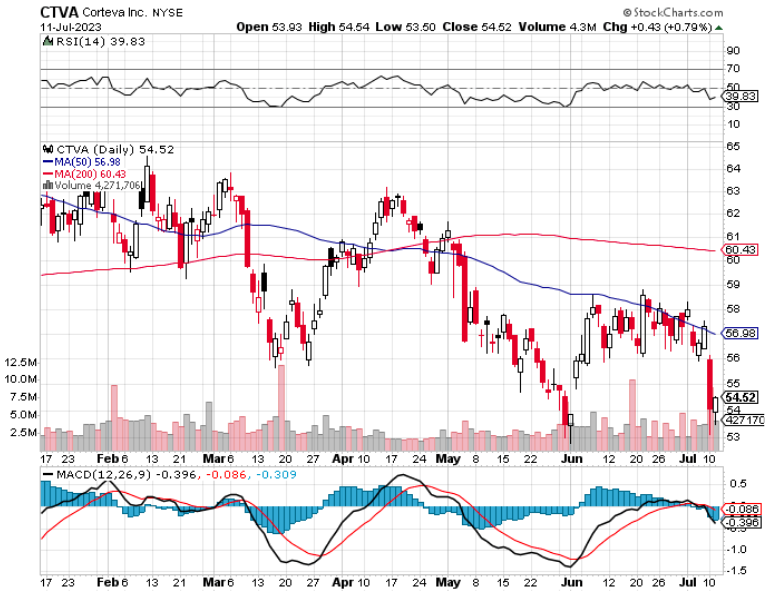(DE), (CNHI), (ADM), (BAYRY), (CTVA)
In all the chatter about artificial intelligence (AI), from chatty bots like ChatGPT to autonomous cars and predictive typing, seldom do we acknowledge its transformative power in a sector that keeps our world turning: agriculture.
I bet your grandpa would have spilled his coffee with laughter if someone told him his trusty John Deere would one day steer itself. Well, fasten your seat belts, because with AI in the driving seat, self-operating tractors are no longer a matter of “if,” but “when.”
Bursting into life, the farming industry is ready to embrace the next wave of technological revolution.
In 2020, a staggering $25 billion was plowed into tractors and other mechanized marvels, evidence that farmers are beginning to see the glittering potential of high-tech tools.
Despite Covid-19 attempting to halt the march of progress, the rapid adoption of robotics on the farmstead is expected to outstrip even the industrial market, rocketing at a rate of 19.3% over the next five years.
We're talking big money here, folks, with the robotic investment market predicted to rise from a cool $5 billion in 2021 to a jaw-dropping $12 billion by 2026.
This golden age of agtech is sparking an investment frenzy, with venture capitalists pouring an unprecedented $4 billion into agtech startups in the third quarter of 2021 alone.
Pioneering corporations like John Deere (DE) and CNH Industrial (CNHI) are gearing up a revolution, engineering intelligent tractors capable of executing tasks such as sowing, plowing, and reaping with zero human intervention.
In fact, John Deere is already rolling out its first fully autonomous tractor, a souped-up version of the well-loved Model 8R tractor.
These marvels of machine learning, equipped with GPS and sensory systems, manoeuvre farmlands with aplomb, dodge hurdles, and accomplish tasks with unparalleled efficiency. No coffee breaks, no fatigue, and definitely no grumbling about the boss.
But the revolution doesn't stop at tractors.
In the past, farming relied heavily on intuition and the well-worn pages of the Farmer's Almanac. Now, AI acts like an ultra-smart farming assistant, sifting through vast amounts of data, predicting crop yields, spotting disease outbreaks, and keeping tabs on soil health. Welcome to farming 2.0.
Take, for instance, the game-changing role of AI-driven drones, armed with multispectral imaging sensors.
Companies like PrecisionHawk and DroneDeploy are revolutionizing agricultural drone systems, pairing AI and drone tech to equip farmers with data-driven insights. These insights bolster crop yields and promote sustainable farming practices.
They fly over vast fields, capturing vital data and pinpointing areas under siege from pests or diseases. Farmers, armed with this crucial data, can intervene timely and decisively, minimizing crop loss and maximizing yield quality.
The outcome?
Farmers are provided with invaluable insights - when to plant, what to cultivate, when to water, and when to harvest. The result isn't just improved efficiency - it's like owning a crystal ball backed by scientific rigor rather than mere hocus pocus.
The impact of AI in agriculture isn't limited to crops alone - it's transforming livestock management too. So, step aside, cowboys. It's time for AI to lead the herd.
AI-based solutions, like those provided by Cainthus and Connecterra, are giving farmers the ability to monitor their livestock's health and welfare, identifying patterns indicative of illness or stress.
The result? Healthier, happier animals, and let's be real, happier cows do make better milk. It may not be rocket science, but it sure rings true.
But, the ultimate question still looms: will the farming community embrace this AI revolution?
The key lies in showcasing the tangible benefits to farmers, making the adoption of these technologies a no-brainer. That is, if AI can provide a clear value proposition, farmers won't hesitate to choose it.
After all, the AI revolution in farming isn't just about fancier tech. It's about giving farmers the tools they need to work smarter, not harder.
Zoom in on the investment scene and you'll find agriculture-centric ETFs such as iShares MSCI Agriculture Producers ETF (VEGI) trading near their zenith, despite commodities like corn, soybeans, and wheat recoiling amidst recession fears and dipping oil prices as of July 2022.
The mightier dollar is also nudging ag commodities like fertilizer, since it's making globally-priced commodities pricier in non-dollar currencies, thereby lowering their price.
Besides, let's not kid ourselves – agribusiness is no small potatoes. The scale at which it operates has coalesced market power into a select group of Goliaths, making them attractive investment prospects. These cash-rich, profit-making machines span a spectrum of industries and are a lucrative avenue for those with a keen eye on dividends.
Case in point: Archer-Daniels-Midland (ADM), a behemoth in the agricultural sector known for its processing and trading operations.
ADM is a Jack-of-all-trades, dealing in a plethora of crops and championing innovations from textured vegetable protein to Omega-3 fatty acids.
With a whopping $102 billion revenue in 2022, and having paid dividends unfailingly for 91 years straight, ADM is a Dividend King, delivering consistent profit growth since 2016.
Then there's Bayer (BAYRY), a multifaceted entity that spans healthcare, agriculture, and consumer goods.
From aspirin to Alka-Seltzer and the renowned weed-killer Roundup, Bayer's got its hands in many pies. Thanks to tight supply bolstering prices, it’s also celebrating a record-breaking year with a revenue surge to $27.8 billion in 2022 in its crop science division.
Another player that's made a mark is Corteva Agriscience (CTVA), a byproduct of DowDuPont's agriculture division's spin-off. Corteva excels in crop protection products and seed products, coupled with digital tools like planting technology and soil mapping.
A stellar performance in 2022 has set them up for what promises to be a fruitful 2023, with plans for substantial growth through 2025.
The fusion of AI with farming isn't some far-fetched idea. It’s already a tangible reality, with farmers capitalizing on AI capabilities to enhance their operations, manage resources, and make insightful decisions.
This digital revolution is playing a crucial role in catering to the global food demand while reducing the environmental footprint, making the future of farming look incredibly promising.





